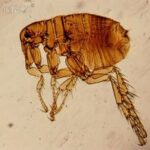From the heat of summer to the dead of winter, fleas can infest our pets. They lurk outside in the grass, in the warm pile of indoor carpet and even cling to our clothing — making the bugs a nuisance year-round. If you’re looking for a natural, flea preventative for your pet consider products made with cedar oil.
Sources of Cedar Oil
Since the United States Environmental Protection Agency deemed cedar wood oil non-toxic, cedars, cypress trees and junipers have provided the essential oil and wood shavings commonly found in topical flea prevention medications and pest-repelling cedar-filled dog bedding.
Look for cedar oil in flea prevention pet shampoos. When labeled as a dominant ingredient to repel fleas, this type of shampoo should not be used in conjunction with a topical flea prevention treatment such as spot-on drops or a flea collar. Overdosing can occur. The pet may become ill, develop a skin rash or act lethargic, according to the EPA.
Additional Benefits of Cedar Oil
Cedar oil also repels moths and retards the growth of mold and mildew, making it an ideal choice for pets housed in garages, barns or outdoor kennels. When the pet’s bedding no longer has an aromatic scent, re-fill the bed with fresh wood shavings for optimal protection from fleas. Since using cedar oil-based wood shavings for a bedding is not a topical treatment, frequent bedding changes will not cause an overdosing reaction for the pet.
Other Flea Products Pose Risks
The Journal of Pesticide Reform reviewed a 1997 study of flea control products conducted by The Northwest Coalition For Alternatives To Pesticides (NCAP) . Although the study — which did not include cedar oil — noted half of the products tested as carcinogenic, two-thirds neurotoxic and all products are a threat to the environment when disposed. These findings make natural flea prevention ideas even more appealing to pet owners.
If you suspect your pet has experienced an adverse reaction to any flea prevention product, visit your veterinarian for medical assistance. Then, ask your veterinarian to report the illness the National Pesticide Information Center’s Veterinary Pesticide Incident Reporting Portal HERE.
Related Article:
Natural Flea Prevention Ideas for Dogs
Sources and Suggested Further Reading:
United States Environmental Protection Agency, Office of Prevention, Pesticides and Toxic Substances: Wood Oils and Gums
Doctors Foster and Smith Pet Education: Ingredients in Flea & Tick Control Products for Dogs
National Pesticide Information Center: Veterinary Pesticide Incident Reporting
United State s Environment al Protection Agency: EPA Evaluation of Pet Spot-On Products: Analysis and Mitigation Plan
Northwest Coalition For Alternatives To Pesticides/NCAP, Journal of Pesticide Reform: Managing Fleas Without Poisons
Department of Health and Human Services: Summary of Data for Chemical Selection
###
Reference:
- Natural Flea Prevention Ideas for Dogs: www.associatedcontent.com/article/293487/natural_flea_prevention_ideas_for_dogs.html?
- Facts About Rimadyl for Dogs: www.associatedcontent.com/article/6095822/facts_about_rimadyl.html?cat=53
- Artifical Sweetner That Poisons Pets: www.associatedcontent.com/article/5854586/artificial_sweetener_xylitol_can_poison.htm






